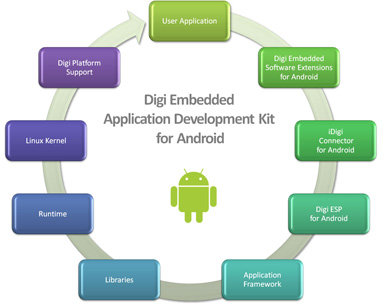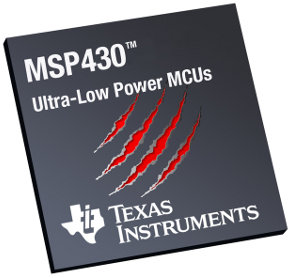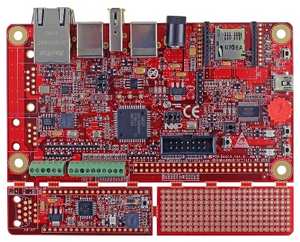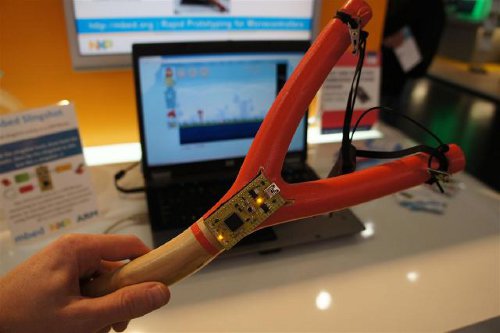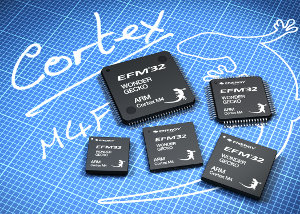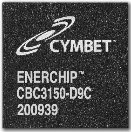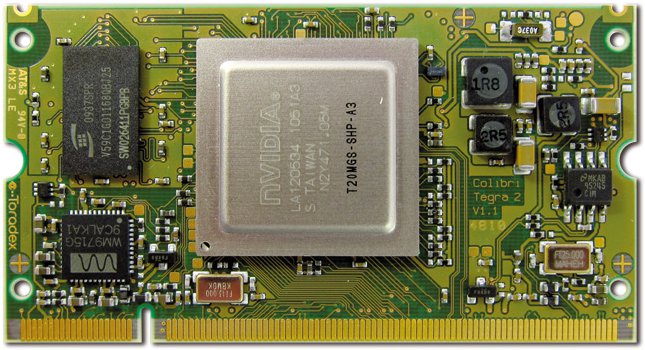Digi International has released its Application Development Kit for Android (the world first Android embedded application devkit according to the company) at Embedded World 2012. This Development Kit is comprised of both software and hardware components. The software development kit (SDK) includes drivers and Digi software extensions to create Android-based applications on embedded platforms while eliminating tedious driver development work. The kit also includes one of 2 Digi Wireless modules based Freescale i.MX51 (ConnectCore Wi-i.MX51) and i.MX53 (ConnectCore for Wi-i.MX53). The complete Digi Android development kit includes: Quick start guide Digi Application Development Kit for Android CD/DVD Documentation and development board schematics ConnectCore Wi-i.MX53 module – 1 GHz Freescale i.MX53, 512 MB NAND Flash, 512 MB DDR2, -20 to +70° C. 7″ WVGA LCD panel with touchscreen Digi JumpStart Kit development board: 3 serial ports (1 x RS-232/422/485, 1 x RS-232 Tx/Rx, 1 x TTL) VGA and HDMI 1.3 video outputs […]
Texas Instruments Announces Ultra-Low Power MSP430 “Wolverine” MCU Series
Texas Instruments announced a new series of its MSP430 MCUs codenamed “Wolverine” for its aggressive power-saving technology. The company claims this ultra-low-power MSP430 microcontroller platform offers at least 50 percent less power consumption than any other micro-controller in the industry with 360 nA RTC mode and less than 100 µA/MHz active power consumption. Since typical battery powered applications spend as much as 99.9 percent of their time in standby mode, Wolverine MCUs power consumption of 360 nA in standby mode would more than double the battery life. Here are the key power savings techniques and technology using the the Wolverine MCU (MSP430FR58xx): Ultra low leakage (ULL) process technology. TI developed ULL technology that offers a 10x improvement in leakage and optimized mixed signal capabilities. Power reduction are also achieved thanks to an improved 130 nm process technology and more than 30 power-optimized analog and digital components. Unified FRAM (Ferroelectric Random […]
Embedded Artists and NXP Release The First ARM Cortex-M Android Open Accessory Development Kit
Embedded Artists and NXP introduced the TN-20764, a board that can be used with Android Open Accessory Application (AOAA) development kit that features 2 NXP Cortex-M MCUs, at Embedded World 2012. The board includes Ethernet, CAN and IEEE 802.15.4 interfaces as well as a remote CAN node, enabling designers to develop accessories for consumer applications, as well as home, building and industrial automation applications requiring different types of connectivity. There are already Arduino and PIC-based Android Open Accessories, but this board is the first AOAA kit based on ARM Cortex-M micro-controllers. As mentioned above, the board features 2 Cortex M micro-controllers: The NXP LPC1769, a 120-MHz Cortex-M3 based MCU, provides the interface to the Android mobile device via its full-speed USB transceiver . The LPC1769 also includes 512 KB flash and 64 KB on-chip SRAM, an Ethernet MAC, a CAN 2.0B controller, an 8-channel, a 12-bit ADC, a 10-bit DAC, […]
Play Angry Birds For Real with Mbed NXP Cortex-M0 Slingshot
If you’re just bored to play Angry Birds with the touchscreen of your smartphone or with your mouse in Angry Birds for Chrome, you can now bring the fun back to the game by playing with a real slingshot ! mbed designed a USB slingshot with an mbed NXP LPC11U24 (Cortex-M0 MCU) board that emulates a USB mouse. mbed measures the angle and strength applied with: An accelerometer that measure the tilt by tracking the gravity vector A rubber stretch sensor used as the sling, and measure how much it is stretched. They built the slingshot with the following hardware components: mbed NXP LPC11U24 board – 59 USD 3-axis Accelerometer – ADXL345 Accelerometer connect via SPI – 14.95 USD Stretch Sensor connected to pin 15 (analog input) – 9.95 USD USB B connector Handcrafted Slingshot Here’s how mbed describes their NXP board: The mbed NXP LPC11U24 MCU module is a […]
Energy Micro Introduces Cortex-M4F EFM32 Wonder Gecko MCU Series
Energy Micro has just announced the EFM32 Wonder Gecko series with the addition of 60 ARM Cortex-M4F based MCU to its Gecko offering or a total of 240 MCUs. The new controllers are highly energy efficient and minimize energy consumption by including a flexible range of standby and sleep modes, intelligent peripherals that allow designers to implement many functions without CPU wake-up, and ultra-low standby current. Wonder Gecko MCUs come with 256KB Flash memory and 32KB RAM and can achieve active mode current consumption of just 180µA/MHz. Devices provide a deep sleep mode that consumes just 400nA with RTC running, a shut-off mode requiring only 20nA and wake-up time as short as 2µs. The company explains that the LESENSE function block, a generic low energy sensor interface, enables monitoring of a mix of up to 16 capacitive, inductive or resistive sensors while the MCU core is in sleep or shut-off […]
Atollic TrueSTUDIO for ARM 3.0 To Be Released at Embedded World 2012
Atollic has just announced that Atollic TrueSTUDIO for ARM 3.0 – a C/C++ development tool for embedded developers – will be released on the 28th of February 2012, at Embedded World 2012, Nuremberg, Germany. Atollic TrueSTUDIO v3.0 will bring the following improvements: Redesigned user interface that is more intuitive to C/C++ developers New support for NXP LPC1000 Cortex-M0 and Cortex-M3 devices New support for Infineon XMC4000 Cortex-M4 devices New support for Energy Micro EFM32 (Cortex-M3) Upgraded support for STMicroelectronics STM32 devices Improved real-time interrupt tracing with ARM Serial Wire Viewer (SWV) interface. Execution time profiling now present information using bar charts Upgraded ECLIPSE platform to the latest “Indigo” release (3.7.1) Major upgrade of the GNU command line tools Upgraded TrueINSPECTOR, TrueANALYZER and TrueVERIFIER add-on products Supports over 800 ARM devices Hundreds of minor improvements Since the product has not been released, that’s currently all information there is. Further information will certainly […]
Cymbet EnerChip Solid State Batteries and Energy Harvesting Evaluation Kits
Cymbet has developed rechargeable solid state batteries called EnerChip for Embedded Energy, Power Backup and Energy Harvesting. Applications include backing up Real Time Clocks (RTC), Micro-controllers (MCU) and SRAM devices. The company says “EnerChips are ideal for energy harvesting powered devices such as wireless sensors, medical devices, data loggers and remote location tracking equipment.” Those chipsets aim at replacing batteries such as CR2032 batteries that you can find in watches, calculators and other low power devices. The company emphasized three key benefits of such “batteries”: EnerChips are more than 10x smaller than non-rechargeable coin cell batteries EnerChips last 3x longer than conventional coin cell batteries EnerChips are less expensive to use than conventional coin cell batteries or super caps. The price starts at 20 US cents in volume quantities. You can watch the promotion video below for an overview of those chips. Cymbet shows a lot of mobile phones in their video, […]
Toradex Will Unveil Colibri T30 Nvidia Tegra 3 COM at Embedded World 2012
Toradex, a Swiss technology company specialized in embedded systems, will be at Embedded World 2012 to showcase their products and technology including: An Embedded Computer Kit with Colibri T20 (Nvidia Tegra 2 Computer on Module) and Iris carrier board. Instant boot demo (480 ms) in WinCE with their NVidia COM The new Colibri T30 COM powered by Nvidia Tegra 3 (Quad-core Cortex A9 processor) At the conference, they will give away 100 Embedded Computer Kits (they also call it “Performance Kit”) based on Colibri T20 and Iris board to the attendees who give 20 Euros to the Red Cross. The regular price of this kit is 200 Euros. This embedded module comes preloaded with Windows Embedded Compact 7 , but you can download the Linux BSP and update the board firmware. The Colibri T20 key features include: Dual Core Nvidia Tegra 2 ARM Cortex A9 Processor @ 1 Ghz 256 […]


